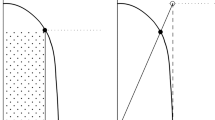Abstract
In this paper we define the Extended Linear Complementarity Problem (ELCP), an extension of the well-known Linear Complementarity Problem (LCP). We show that the ELCP can be viewed as a kind of unifying framework for the LCP and its various generalizations. We study the general solution set of an ELCP and we develop an algorithm to find all its solutions. We also show that the general ELCP is an NP-hard problem.
Similar content being viewed by others
References
F.A. Al-Khayyal, “An implicit enumeration procedure for the general linear complementarity problem,”Mathematical Programming Study 31 (1987) 1–20.
F. Baccelli, G. Cohen, G.J. Olsder and J.P. Quadrat,Synchronization and Linearity (Wiley, New York, 1992).
R. Carraghan and P.M. Pardalos, “An exact algorithm for the maximum clique problem,”Operations Research Letters 9 (6) (1990) 375–382.
S. Chung, “NP-completeness of the linear complementarity problem,”Journal of Optimization Theory and Applications 60 (3) (1989) 393–399.
R.W. Cottle and G.B. Dantzig, “A generalization of the linear complementarity problem,”Journal of Combinatorial Theory 8 (1) (1970) 79–90.
R.W. Cottle, J.S. Pang and R.E. Stone,The Linear Complementarity Problem (Academic Press, Boston, 1992).
R.A. Cuninghame-Green,Minimax Algebra, Lecture Notes in Economics and Mathematical Systems, Vol. 166 (Springer, Berlin, 1979).
B. De Moor, “Mathematical concepts and techniques for modelling of static and dynamic systems,” Ph.D. Thesis, Department of Electrical Engineering, Katholieke Universiteit Leuven, Leuven, Belgium (1988).
B. De Moor, L. Vandenberghe and J. Vandewalle, “The generalized linear complementarity problem and an algorithm to find all its solutions,”Mathematical Programming 57 (1992) 415–426.
B. De Schutter and B. De Moor, “Minimal realization in the max algebra is an extended linear complementarity problem,”Systems & Control Letters 25 (2) (1995) 103–111.
B. De Schutter and B. De Moor, “A method to find all solutions of a system of multivariate polynomial equalities and inequalities in the max algebra,”Discrete Event Dynamic Systems: Theory and Applications, to appear.
B. De Schutter and B. De Moor, “The characteristic equation and minimal state space realization of SISO systems in the max algebra,” in: G. Cohen and J.-P. Quadrat, eds.,Proceedings of the 11th International Conference on Analysis and Optimization of Systems, Sophia-Antipolis, France, Lecture Notes in Control and Information Sciences, Vol. 199 (Springer, New York, 1994) pp. 273–282.
A.A. Ebiefung and M.K. Kostreva, “Global solvability of generalized linear complementarity problems and a related class of polynomial complementarity problems,” in: C.A. Floudas and P.M. Pardalos, eds.,Recent Advances in Global Optimization, Princeton Series in Computer Science (Princeton University Press, Princeton, NJ, 1992) pp. 102–124.
M.R. Garey and D.S. Johnson,Computers and Intractability: A Guide to the Theory of NP-Completeness (Freeman, San Francisco, CA, 1979).
P.E. Gill and W. Murray,Numerical Methods for Constrained Optimization (Academic Press, London, 1974).
M.S. Gowda and R. Sznajder, “The generalized order linear complementarity problem,”SIAM Journal on Matrix Analysis and Applications 15 (3) (1994) 779–795.
M.S. Gowda, “On the extended linear complementarity problem,”Mathematical Programming, to appear.
J.J. Júdice and L.N. Vicente, “On the solution and complexity of a generalized linear complementarity problem,”Journal of Global Optimization 4 (4) (1994) 415–424.
J.A. Kaliski and Y. Ye, “An extension of the potential reduction algorithm for linear complementarity problems with some priority goals,”Linear Algebra and its Applications 193 (1993) 35–50.
O.L. Mangasarian and J.S. Pang, “The extended linear complementarity problem,”SIAM Journal on Matrix Analysis and Applications 16 (12) (1995) 359–368.
O.L. Mangasarian and M.V. Solodov, “Nonlinear complementarity as unconstrained and constrained minimization,”Mathematical Programming 62 (2) (1993) 277–297.
T.H. Mattheiss and D.S. Rubin, “A survey and comparison of methods for finding all vertices of convex polyhedral sets,”Mathematics of Operations Research 5 (2) (1980) 167–185.
K. McShane, “Superlinearly convergent\(O\left( {\sqrt n L} \right)\)-iteration interior-point algorithms for linear programming and the monotone linear complementarity problem,”SIAM Journal on Optimization 4 (2) (1994) 247–261.
S. Mehrotra and R.A. Stubbs, “Predictor-corrector methods for a class of linear complementarity problems,”SIAM Journal on Optimization 4 (2) (1994) 441–453.
T.S. Motzkin, H. Raiffa, G.L. Thompson and R.M. Thrall, “The double description method,” in: H.W. Kuhn and A.W. Tucker, eds.,Contributions to the Theory of Games, Annals of Mathematics Studies, Vol. 28 (Princeton University Press, Princeton, NJ, 1953) pp. 51–73.
P.M. Pardalos and J.B. Rosen,Constrained Global Optimization: Algorithms and Applications, Lecture Notes in Computer Science, Vol. 268 (Springer, Berlin, 1987).
P.M. Pardalos and J. Xue, “The maximum clique problem,”Journal of Global Optimization 4 (1994) 301–328.
A. Schrijver,Theory of Linear and Integer Programming (Wiley, Chichester, 1986).
M. Sun, “Monotonicity of Mangasarian's iterative algorithm for generalized linear complementarity problems,”Journal of Mathematical Analysis and Applications 144 (1989) 474–485.
R. Sznajder and M.S. Gowda, “Generalizations ofP 0- andP-properties; extended vertical and horizontal LCPs,”Linear Algebra and its Applications 223–224 (1995) 695–716.
R.H. Tütüncü and M.J. Todd, “Reducing horizontal linear complementarity problems,”Linear Algebra and its Application 223–224 (1995) 717–730.
L. Vandenberghe, B. De Moor and J. Vandewalle, “The generalized linear complementarity problem applied to the complete analysis of resistive piecewise-linear circuits,”IEEE Transactions on Circuits and Systems 36 (11) (1989) 1382–1391.
Y. Ye, “A fully polynomial-time approximation algorithm for computing a stationary point of the general linear complementarity problem,”Mathematics of Operations Research 18 (2) (1993) 334–345.
Y. Zhang, “On the convergence of a class of infeasible interior-point methods for the horizontal linear complementarity problem,”SIAM Journal on Optimization 4 (1) (1994) 208–227.
Author information
Authors and Affiliations
Additional information
This paper presents research results of the Belgian programme on interuniversity attraction poles (IUAP-50) initiated by the Belgian State, Prime Minister's Office for Science, Technology and Culture. The scientific responsibility is assumed by its authors.
Supported by the N.F.W.O. (Belgian National Fund for Scientific Research).
Rights and permissions
About this article
Cite this article
De Schutter, B., De Moor, B. The extended linear complementarity problem. Mathematical Programming 71, 289–325 (1995). https://doi.org/10.1007/BF01590958
Received:
Revised:
Issue Date:
DOI: https://doi.org/10.1007/BF01590958




